Pruning in Artful Ways
June 4th, 2024
June is one of the busiest months of the year for pruning.
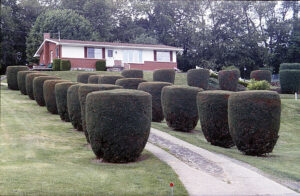
Pruning to many people means shearing the shrubs into “green meatballs.”
It’s prime time to size-control the evergreens, trim the hedges, and thin out and cut back the flowering shrubs that bloomed earlier in spring, such as azaleas, lilacs, weigelas, and deutzias.
For most people, pruning means getting out the power shears (or chainsaw) and “whacking back the bushes” into balls and boxes.
While the resulting “green meatballs” might be quick to do and the norm in American landscaping, they’re not the ideal way to prune woody plants.
All of that tight trimming encourages dense growth that shuts off light to all but the outer leaves and slows the drying of leaves in humid or rainy weather, which translates into more incidence of disease.
Healthier and far more interesting pruning techniques are possible.
Some of them can turn a plain green bush into a work of art, and most of them take just a little know-how and willingness to try something different.
Below are a few novel ways to cut in the landscape. If any intrigue you, please do more research because not all plants appreciate (or survive) all of the following techniques.
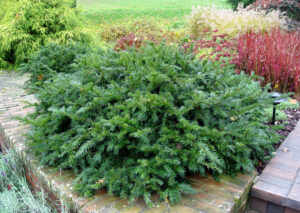
This yew has been thinned and shaped, not sheared into a ball.
Thinning
Rather than whacking everything back around the perimeter, this type of pruning is done selectively, cut by cut, with hand pruners for the small branches and loppers for the bigger ones.
The idea is to open the plant so light gets inside the canopy and encourages growth farther in. In sheared bushes, look inside, and you’ll notice how the inner branches are bare, with almost all of the growth occurring at the tips.
Opening the canopy also improves air flow, which is one of the best natural disease-fighting strategies.
Thinning a tree or shrub is best done early in the season before the plant leafs out. You can see the branch structure much better then. But June is also fine for plants other than those that are in bloom or yet to bloom this season.
First, look for crossing branches and cut out one of the competitors back to where it emerges from the trunk or a bigger branch.
Then look for areas where several twigs or branches are coming out from the same general area. Identify the one that’s growing in the best direction and remove the rest.
Third, look for branches that are growing inward. Remove those, too, or cut them back to just above a bud or branch that’s facing outward to re-direct the growth.
Finally, stand back and look to see if the plant is evenly balanced and open evenly throughout. If not, remove or shorten branches until you’re happy.
This type of pruning leaves you with more natural-looking plants, but it can be done with formal hedging, too. Thin first, then trim after you’ve opened each plant a bit.
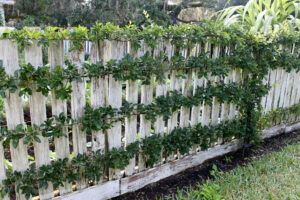
This apple tree has been espaliered into three levels of “arms.”
Espalier
Here’s a space-saving technique that looks a lot harder to pull off than it really is.
Espaliering (es-PAH-lee-aying) trains plants to grow vertically and nearly flat upwards by 1.) tying selected young branches to a frame, 2.) pruning off everything that wants to grow out or back, and 3.) shortening the remaining branches each year to stay within the chosen pattern.
The classic form is a double or triple cordon in which one branch is trained coming out to the right, one opposite it coming out to the left, and then one or two more layers a foot or two above that first set of “arms.”
By tying branches to pre-installed frames, you can make those branches go up and out most any way you’d like – into candelabras, fans, or crisscrossing “Belgian fences.”
This is a great way to dress up a wall or fence where you don’t have a lot of bed width to work with. Plus, it really makes it look like you know what you’re doing.

These are examples of landscape plants trimmed into topiary forms.
Topiary
This pruning technique also trains plants into shapes, except it’s not just a flat, vertical pattern.
Topiaries involve trimming plants into a 3D work of art – most often spirals or pom-poms but really any shape you can manage.
Some topiaries are done by starting with 3D frames that are filled with sphagnum moss and then planted with short, compact creeping perennials or groundcovers – often succulents.
Landscape specimens, however, are usually live evergreens that are planted and trimmed into the shapes with shears and/or pruners.
With these, the easiest strategy is to buy a plant that’s already been trained into the form you like. Then you just have to trim often enough to keep it that way as it grows.
Otherwise, buy a young plant and start carving. Boxwoods, yews, junipers, hollies, and arborvitae are five evergreens that among the best to topiary.
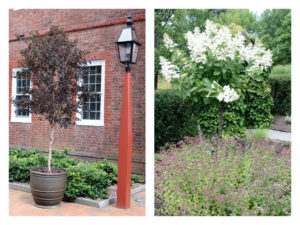
A standard is a shrub pruned into a small single-trunk form.
Standards
Usually done to roses, a standard is when you remove all of the lower branches of a growing plant so that just the top is allowed to branch and leaf out. The result is the look of a miniature tree.
You can buy or train roses to standards, but it’s also a technique you can use on other shrubs to turn an ordinary bush into a specimen mini blooming tree.
I’ve seen it done to lilacs and butterfly bushes, and I once converted a fairly common dark-leafed ‘Diabolo’ ninebark into a standard. Even experienced gardeners were surprised at what plant it was because it was so out of the ordinary.
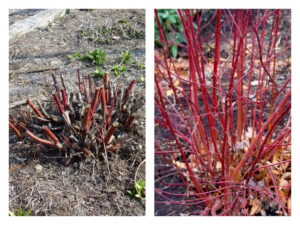
This redtwig dogwood has been “coppiced” at left to encourage all-new and more colorful stems.
Coppicing
Coppicing involves cutting all stems down to about three to four inches at the end of each winter.
It’s done for a few reasons… to encourage all-new growth that has the best stem color (as in red-twig and gold-twig dogwoods), to limit the size of super-fast growers (paulownia, elderberry, and vitex, for example), to rejuvenate a big old shrub (lilac, beautybush, butterfly bush), or to improve the look of shrubs whose leaf color is best on new wood (purple smokebush and variegated willow).
Coppicing sounds brutal, and in fact, it can kill plants that aren’t adept at pushing new growth from those three- to four-inch stubs.
Done to the right plant at the right time, though, it’s one of the best things you can do for the look and performance of the plant.
Read George’s column on “Why would you want to cut a plant almost to the ground?”
Pollarding
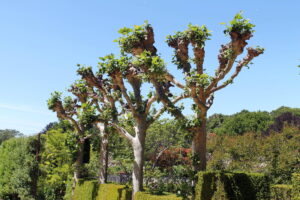
These London plane trees have been pollarded.
Like coppicing, pollarding is extreme pruning, too, except this one involves cutting back each branch to the same point each year.
What that does is encourage the formation of a “knob” from which multiple new branches emerge each spring.
The idea is mainly to control the spread of a tree, although it looks pretty interesting when you see it (assuming you’re OK with the idea of man controlling nature… if not, it’ll seem like tree torture).
Again, not all trees respond well to this time-consuming technique, but it works best with small ornamental trees such as crape myrtles, crabapples, flowering cherries, and mulberries.
In urban landscapes, it’s a way to keep big sycamores, lindens, and tulip trees out of power lines and off walls.
Garden bonsai
Most people are familiar with the Oriental plant art of bonsai in which the artist miniaturizes a tree by growing it in a shallow pot and meticulously pruning the branches and roots.
Something similar can be done with in-ground plants, except you won’t be digging up the plants to prune the roots.
The idea is to try and create a unique shape, ideally by pruning to encourage the shape and direction the tree wants to take. You might end up with something that looks wind-blown or that resembles the skeleton of an animal.
One of the tricks is pruning just above a bud that’s heading in the direction where you’d like the branch to go.
Small deciduous trees are some of the best, such as Japanese maple, dogwood, and seven-son flower, but most evergreens are fine, too, especially pine and juniper.
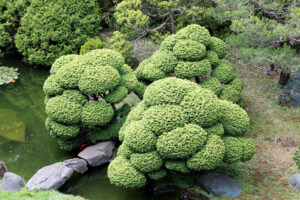
These evergreens have been sheared into cloud forms in a technique known as niwacki.
Cloud pruning
A related Oriental plant art called niwaki is trimming, pruning, and branch-training to create a series of rounded forms that resemble clouds.
You can prune densely to create a shrub that looks to have a cluster of clouds or more open to create something that looks like green puffballs on the end of branch arms.
Dense evergreens take to this technique best, i.e. boxwood, yew, privet, Japanese holly, and pine.
Check out Jake Hobson’s book on how to do niwaki
Pleaching

These hornbeam trees have been pleached into a sort of high hedge.
Originally done to make living, interwoven fences out of trees, pleaching is one of the most extreme examples of man controlling nature.
European estates turned simple fences into grand walls, ceilings, and tunnels made out of closely planted trees, trained up frames and then cut regularly into neat oversized hedges.
It’s pretty labor-intensive but very impressive, which is why you see pleached trees only in public gardens or estates with paid gardening staffs.
Hornbeams, beech, and linden are the three most common trees used in pleaching if you’re wild and crazy enough to take a crack at it.
Pooktre
Wildest and craziest of all is this art of growing trees into odd or creative geometric shapes and objects.
It’s typically done by interweaving and grafting branches of live and growing trees into sometimes-unbelievable shapes, including bridges, basket-weaves, and even “tree chairs” that you can sit on.
Check out Wikipedia’s detailed article on pooktre or “tree-shaping” for examples, history, and a how-to.







